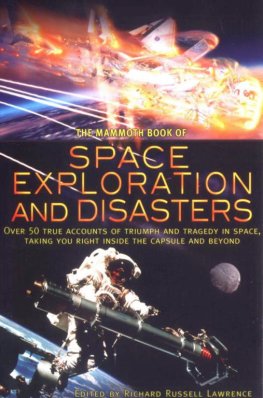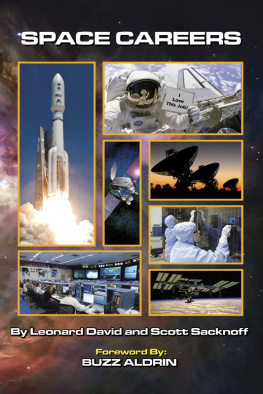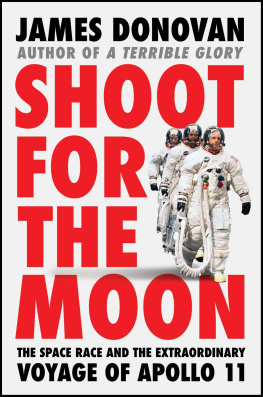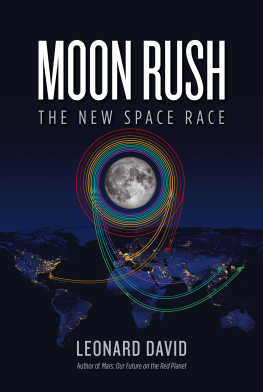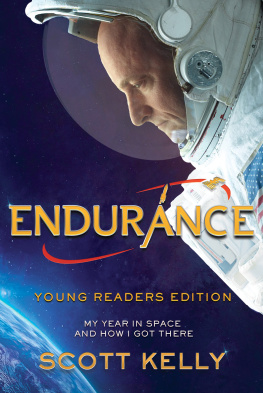
Alexei Leonov and David Scott in Soyuz simulator, Star City, June 1973

The author and publisher have provided this e-book to you for your personal use only. You may not make this e-book publicly available in any way. Copyright infringement is against the law. If you believe the copy of this e-book you are reading infringes on the authors copyright, please notify the publisher at: us.macmillanusa.com/piracy.
Contents
To Charlie Bassett
astronaut extraordinaire, taken before his time
and Jim Irwin
my partner on the Moon, the very best.
D.S.
To Sergei Pavlovich Korolev
outstanding scholar of the twentieth century, great citizen of Russia, founder of practical cosmonautics
and Yuri Gagarin
my friend with whom we jointly started our way to space, on the same day, 4 October 1959.
A.L.
FOREWORD
In Two Sides of the Moon , David Scott and Alexei Leonov recount the preparation for and execution of the most elaborate non-military competition in history. Each man would play a vital and high-profile role in that contest. In all great competitions success is dependent on a combination of skill, preparation and an element of luck. Certainly all these factors played critical roles for both sides. The reader will gather detailed insights into the strategies, successes, concerns and tragedies of each team. It is unlikely that the space race was the diversion which prevented war. Nevertheless, it was a diversion and provided an outlet that replaced the brinksmanship of the early 1950s that might well have led to armed conflict. The competition was intense and allowed both sides to take the high road with the objectives of science and learning. Eventually it provided a mechanism for engendering cooperation between adversaries and it provided an enduring legacyan enormous improvement of the understanding of our cosmic neighborhood and indeed of our Earth itself.
It is commonly believed that the space age began because of the Cold War between the West, led by the United States, and the Communist Bloc, led by the Soviet Union. That belief is not quite right. The space age actually began because of a scientific event known as the International Geophysical Year. Sixty-six countries joined together to analyze the planet Earth and its environs: oceanography, meteorology, solar activity, the Earths magnetic fields, the upper atmosphere, cosmic rays and meteors. The International Geophysical Year was planned for the period 1 July 1957 to 31 December 1958. It was, in fact, the International Geophysical Year and a Half. That particular time was selected because it was the time of maximum sunspot activity. All sorts of unexplained electrical, magnetic and weather phenomena seemed to be somehow related to sunspots.
Soviet and American scientists recognized that if it would be possible to place a manmade object into orbit around the Earth, it would be the perfect platform for sensors and recording instruments to measure many of the characteristics of the natural world for which the International Geophysical Year was created.
They did not realize it at the time but they had started a new competition which would become known as the space race. The Soviets took an early lead with the successful launch of the first Earth-orbiting satellite, Sputnik. They increased their lead with a series of firsts: first to put a living creaturea doginto orbit; first to put a man into space; first to have a person exit a spacecraft; first to put a woman in orbit; first to launch a multi-crew spaceship and first to fly unmanned probes to the Moon, Venus and Mars.
The American program was substantially behind but not moribund. The Americans were embarrassed but eager to be a part of the race and determined to succeed. United States President John F. Kennedy asked the National Aeronautics and Space Administration to report on our ability to successfully compete with the Soviets. The NASA officials told the President that the United States could not provide the first space laboratory and had only a slim chance of flying around the Moon first but would have a chance, with a concerted national effort, to land a man on the Moon first.
Although this was an arena in which he knew little, Kennedy concluded that the United States must be in the race and must perform well. He received the support of the Congress and of the American people. The race was underway.
This book is the story of that race as told by two of the principal competing participants. Each side respected the other. They were, in fact, able to understand, perhaps better than anyone, the problems, challenges and risks before them. On rare occasions the competitors met at international events and technical conferences for short periods and found that they liked one another, although, coming from opposing sides, they didnt know whether they could trust one another.
Two Sides of the Moon interweaves the tactics of the Soviet program with those of the American effort. The reader will see the plans being developed in the training and operations centers in Moscow and Houston and will live with the cosmonauts and astronauts inside their spacecraft as they learn to exist and survive in dangerous and inhospitable space.
Dave Scott and Alexei Leonov have each borne the enormous responsibility of commanding spacecraft and of representing their respective countries in the most fascinating and most expensive race in human history. This is their transcendent recounting of that competition.
Neil Armstrong, 2004
INTRODUCTION
With the turn of one or two historical events, Soviet cosmonaut Alexei Leonov might well have spent the 1960s and the 1970s trying to kill American astronaut David Scott and vice versa. Leonov in his MiG and Scott in his Super Saber could have taken flight for combat, each trying to blow the other man out of the sky in a contest between the two strongest nations on Earth for political, military and sociological dominance.
Leonov and Scott were highly skilled and expertly trained pilots familiar with the state-of-the-art air weaponry of their respective arsenals. Each man believed that the country of his birth possessed the fairest standard of living and was the best society possible on Earth. Each man was a driven, competitive careerist who took pride in being first, best or at least most colorful in any endeavor. Luckily for them, and for the rest of the world, events never conspired to have them take to the skies to eliminate the other.
Instead, the Russian and the American took flight in separate, far superior ways. An artist at heart, Leonov became a true cosmonaut; the first human being to float in open spacethe only human being at the time to view his beloved Earth and Mother Russia through only the thin faceplate of his pressure suit. Scott, the engineer/ dreamer, commanded the first mission to the Moon where exploration entailed more than landing, walking and picking up rocks. He drove a car on the lunar surface, day after day after day, in search of a geologic treasure as valuable to science as the lost ark would be to theologians.
These two men cheated death on hundreds of occasions throughout their lives. From his childhood during the bleakest period in Soviet history, through his early flying career, to his rigorous and extreme cosmonaut training, Leonov could have easily perished from reasons big and small. A poorly machined airfoil, a faulty valve or a miscalculation in the air pressure of his space suit could have killed him as surely as a momentary hesitation of his brain or body. Dave Scott, having already spent thousands of hours flying aircraft both proven and unproven, narrowly escaped death when the Gemini 8 spacecraft went awry soon after lift-off. A precision landing on the Moon could be a recipe for disasterin fact, it isbut Scott survived his landing colorfully. Both men could have perished in huge balls of fire, the result of their rockets blowing up on the launch pad in either the Baikonur Cosmodrome in the Soviet Union or Cape Kennedy in the United States, without either of them truly earning the title of cosmo- or astronaut.
Next page

